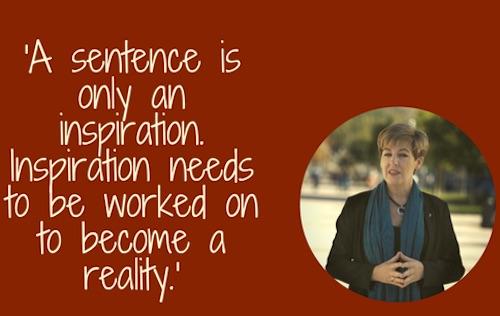How to create real and lasting change with affirmations and declarations?
Social Media is full of quotes, inspiring sentences and recommendations of all kinds without any specifics on how to turn those memorable words into realities. Unless the work is done, words are just words.
The Internet is brimming with inspiring quotes and questions, with magical affirmations and motivational quotes. They’re OK, up to a point. They’re OK in the sense that they can help some people perceive a different interpretation of reality or question their views until that moment. They’re OK because they might trigger introspection and analysis. They’re OK because they might lead some people into avenues until then unexplored. But those sentences are only glimpses onto alternative realities and can only open doors and windows. They’re like signposts on a road, telling us where one could go, if one walked or drove. Unless we move, unless we do the work and strive to live what those sentences and phrases say, our lives will remain the same.
This information is really important when working with clients. If you are a manager in a company and need to help your team, if you work in Human Resources or as a coach, therapist or mentor, you can assist in making real and positive experiential change in peoples lives. The same with motivational talks and messages. If you just give great motivational messages, but not the means to get there, you will be opening a door but not helping them cross the threshold to the other side. Learn how to create lasting positive change at a core level.
You may be interested in deepening your personal journey, if so, its a wonderful opportunity to start delving deeper into self-discovery and growth.
Let me give you an example… affirmations. I do use affirmations with some of my clients, only as part of a bigger plan. Repeating a sentence with intention five times in the morning and five times in the evening, in front of a mirror or in bed will NOT make it come true.
The following Humanology process (it may help to see a professional humanologist initially for the first one or two times) goes beyond traditional affirmations:
- Identify the belief that is limiting you. A professional Humanologist can help to guide you by reviewing your situation and reality.
- Define the affirmations or declarations that you tell yourself about that belief. A professional Humanologist will guide you in identifying and spotting them. Affirmations are statements you make that reflect a certain reality that exists or you wish to have. Declarations are affirmations over which you have full control. For example, an affirmation can be something like “my life is perfect,” whereas a declaration is something like “I make my life perfect.” Nobody can declare anything for you. Declarations reflect your inner beliefs.
- Decide if you want to change the limiting belief.
- Choose a new declaration to replace the limiting effect the old one has. The new declaration needs to comply with some basic rules, which also makes it a bit different from affirmations.
- It must be stated in the affirmative.
- It must be stated in the present tense.
- It must reflect something in your power. It can’t depend on anybody else.
- Start reinforcing it and strengthening it following these simple steps. The declaration will likely not replace the old one unless these steps are followed:
- During the first week, verbally and mentally repeat the new declaration as often as you can.
- Whenever possible, write the new declaration down as many times as you can. Yes, like in school.
- Every time the old affirmation or declaration comes to your mind or words, let it go and repeat the new one five times to yourself, either aloud or silently.
- Whenever the new declaration happens in your life, even if for just a tiny second, celebrate it. You can celebrate it any way you want, but make sure that you allow yourself the feeling of success, achievement, pride, happiness or satisfaction.
- While celebrating, make a gesture of success: high-five yourself, pat your back or kiss your hand, for example.
- Do not attempt to change more than one belief at the same time. One belief per week is the recommended amount.

Let’s now apply it to a real life example. I have quite a few clients who believe themselves to be not good enough so we will apply the technique to this limiting belief:
- Belief: I’m not liked by anybody. I don’t fit in. I can’t do anything right. Every time I try to do something, I get it wrong. Or any similar beliefs.
- Declaration my clients make about themselves: I’m not good enough.
- The person decides to change the underlying belief. To do so, the declaration needs to be altered.
- A new declaration is chosen after working with a Humanologist: I am quite good at a few things. (Observe that this new belief somehow destroys the old one without contradicting it. It’s fundamental to choose new declarations that don’t contradict the old ones, as our brain would not accept those that do).
- It is in the affirmative (negative ones would be something like… I’m not bad. The “not” part would be negative).
- It is in the present (if the declaration is set in the future tense, it will always be in the future, never real).
- It is in the person’s power to decide what he/she is good at
- The person then starts reinforcing it. Observe that the person’s brain will be completely focused on this new declaration when repeating it, so the old one will not be as reinforced as it used to be. In time, not reinforcing the old one will make it lose part of its power. Repetition is fundamental when establishing and changing beliefs.
- The person repeats I am quite good at a few things in front of the mirror every morning and evening, chants it in the car, thinks about it like a mantra for at least a whole week.
- The person sits down and writes the sentence fifty times every day for a week.
- When the old thought, I’m not good enough pops into the person’s mind, it is quickly acknowledged but immediately replaced with the new one: I am quite good at a few things.
- One day, the client is suddenly aware that they did something right. It’s celebration time! The client celebrates that achievement by jumping into the air and feeling good about it.
As you can see, the procedure is not just a matter of reading an inspiring affirmation or quote. It’s not a matter of anybody convincing you, either. It’s much more. It requires serious inner work. Without it, there is no real and lasting change.
If you are a coach, a therapist, an executive or human resource professional, this can be helpful to remember. We all have limitations and beliefs, and giving us inspiring quotes or ideas will not be enough to help us change. There’s a complete process to follow and only by completing it, will our reality change. Inspiring quotes, motivational texts, pep talks and the like can only effectively work when followed and supported by real steps and progress.
Enjoy life… ALL of it,









As always, an amazing article and great reminder!